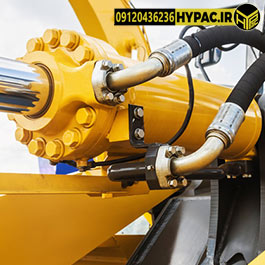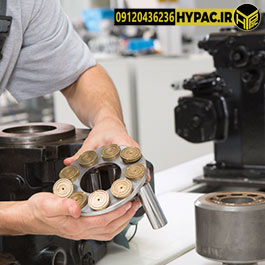Repair and Overhaul of Industrial Hydraulic Systems ــــ ⏱ 5 min read
Repairing and rebuilding hydraulic systems requires technical expertise, experience, and proper tools. Hydraulic systems are used in industrial machinery, vehicles, construction equipment, and many other industries. Below are key steps and tips for hydraulic system repair and overhaul:
Problem Diagnosis (Troubleshooting)
- Oil Leaks: Inspect connections, hoses, seals, and cylinders.
- Low System Pressure: Check pumps, control valves, and leaks.
- Component Malfunction: Slow cylinder movement or unresponsive valves.
- Fluid Contamination: Foreign particles causing component wear.
- Overheating: Inspect cooling systems and oil levels.
- Abnormal Noises: May indicate cavitation or pump damage.
Repair and Overhaul Steps
1. System Depressurization
- Fully depressurize the system before starting work.
- Never open components under pressure (safety first).
2. Component Disassembly
- Carefully remove faulty parts (pumps, valves, cylinders).
- Use appropriate tools for disconnecting fittings.
3. Inspection and Cleaning
- Clean parts with hydraulic-specific solvents.
- Check surfaces for wear, scratches, or corrosion.
- Identify worn seals, O-rings, or gaskets.
4. Replacing Faulty Parts
- Replace or rebuild damaged components (pistons, cylinders, valves).
- Use high-quality seals/O-rings compatible with the system.
5. Reassembly
- Reassemble cleaned/new parts carefully.
- Lubricate seals during installation.
- Tighten fittings to specifications (avoid overtightening).
6. System Testing
- Refill the system with clean hydraulic oil.
- Gradually test pressure and functionality.
- Verify no leaks and proper component operation.
Tools and Equipment
- General Tools: Wrenches, screwdrivers, pliers.
- Specialized Tools: Hydraulic pressure gauges, ultrasonic cleaners.
- Consumables: Hydraulic oil, seals, O-rings, gaskets.
Safety Tips
- Always wear gloves and safety goggles.
- Avoid skin contact with hydraulic oil (may be toxic).
- Work in a clean, dust-free environment to prevent contamination.
Preventive Maintenance
- Regularly replace hydraulic oil and inspect filters.
- Use manufacturer-recommended oil grades.
- Periodically check components for wear or leaks.
When to Consult a Specialist
If the hydraulic system is complex or you lack repair expertise, contact a certified hydraulic technician to avoid further damage.
By following these steps and paying attention to details, you can extend your hydraulic system’s lifespan and prevent unexpected failures. 🛠️
Repair and Overhaul of Hydraulic Systems
Repairing and rebuilding hydraulic systems requires technical expertise, experience, and proper tools. Hydraulic systems are used in industrial machinery, vehicles, construction equipment, and many other industries. Below are key steps and tips for hydraulic system repair and overhaul:
Problem Diagnosis (Troubleshooting)
- Oil Leaks: Inspect connections, hoses, seals, and cylinders.
- Low System Pressure: Check pumps, control valves, and leaks.
- Component Malfunction: Slow cylinder movement or unresponsive valves.
- Fluid Contamination: Foreign particles causing component wear.
- Overheating: Inspect cooling systems and oil levels.
- Abnormal Noises: May indicate cavitation or pump damage.
Repair and Overhaul Steps
1. System Depressurization
- Fully depressurize the system before starting work.
- Never open components under pressure (safety first).
2. Component Disassembly
- Carefully remove faulty parts (pumps, valves, cylinders).
- Use appropriate tools for disconnecting fittings.
3. Inspection and Cleaning
- Clean parts with hydraulic-specific solvents.
- Check surfaces for wear, scratches, or corrosion.
- Identify worn seals, O-rings, or gaskets.
4. Replacing Faulty Parts
- Replace or rebuild damaged components (pistons, cylinders, valves).
- Use high-quality seals/O-rings compatible with the system.
5. Reassembly
- Reassemble cleaned/new parts carefully.
- Lubricate seals during installation.
- Tighten fittings to specifications (avoid overtightening).
6. System Testing
- Refill the system with clean hydraulic oil.
- Gradually test pressure and functionality.
- Verify no leaks and proper component operation.
Tools and Equipment
- General Tools: Wrenches, screwdrivers, pliers.
- Specialized Tools: Hydraulic pressure gauges, ultrasonic cleaners.
- Consumables: Hydraulic oil, seals, O-rings, gaskets.
Safety Tips
- Always wear gloves and safety goggles.
- Avoid skin contact with hydraulic oil (may be toxic).
- Work in a clean, dust-free environment to prevent contamination.
Preventive Maintenance
- Regularly replace hydraulic oil and inspect filters.
- Use manufacturer-recommended oil grades.
- Periodically check components for wear or leaks.
When to Consult a Specialist
If the hydraulic system is complex or you lack repair expertise, contact a certified hydraulic technician to avoid further damage.
By following these steps and paying attention to details, you can extend your hydraulic system’s lifespan and prevent unexpected failures. 🛠️
(Note: Image references are retained as placeholders. Captions can be translated if needed.)(Note: Image references are retained as placeholders. Captions can be translated if needed.)



افزودن دیدگاه